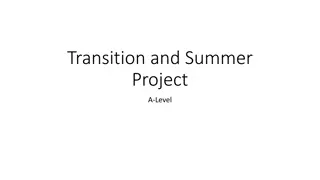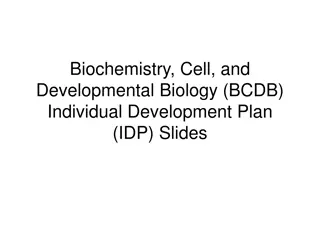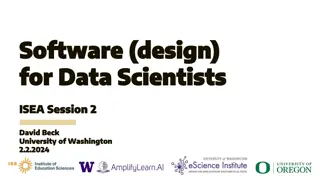Building blocks for organisation and role design
The building blocks for organisation and role design are crucial in developing a modern and integrated organisational structure. Key stakeholders from various teams such as Development, Health, Safety and Wellbeing, and Employee/Industrial Relations need to be involved for effective design. The invo
0 views • 7 slides
GCSE Design Technology Knowledge Organiser and Course Structure Overview
In this detailed knowledge organiser, find information about the GCSE Design Technology course structure, learning objectives, mission statement, and core technical principles for KS4 students. The course emphasizes iterative design cycles, creative thinking, problem-solving, and addressing environm
7 views • 53 slides
Understanding Channel Design in Marketing
Channel design involves planning the distribution of products and services from producers to customers through different business entities or individuals. It encompasses elements like channel flow, channel members, objectives, alternatives, and strategy. Successful channel design aligns with busines
0 views • 13 slides
Understanding Software Analysis and Design Process
Software analysis and design involve a systematic approach to understanding user requirements, creating logical models, and transitioning to detailed design specifications. Requirements analysis focuses on capturing system requirements, while design translates these requirements into implementation
7 views • 16 slides
Understanding the Process and Types of Research Design
The process of research design involves interactive stages that occur simultaneously, leading to the designing of a research study. This includes steps in research design, classification of research design types, such as exploratory, descriptive, and experimental/causal research design. Each type se
12 views • 8 slides
Exploring Game Design Elements and Character Creation Insights
In this content, we delve into various aspects of game design, character creation, and level design. From discussing a character's appearance, personality, abilities, and backstory to analyzing key elements of level design like gameplay mechanics, flow, and storytelling, this comprehensive guide pro
8 views • 10 slides
Textil School for Design, Technology, and Management - Overview
The Textil School for Design, Technology, and Management is a renowned institution funded by the European Union. Offering undergraduate applied studies in Textile and Apparel Design, Textile Engineering, and Management in the Textile Industry, the school focuses on artistic expression, modern method
0 views • 16 slides
If you are searching for Architectural Design in Takapūwāhia
If you are searching for Architectural Design in Takap\u016bw\u0101hia, At HWA - Architecture, we bring years of experience in Architectural Design to projects across New Zealand. With ongoing projects in Otago, Canterbury, Waikato, Kapiti, and Horowhenua, we have established ourselves as a trusted
0 views • 6 slides
Exploring Graphic Design Jobs Near Me: Opportunities and Insights
\n In today's visually-driven world, graphic design plays a crucial role in shaping the identity and communication of businesses, organizations, and brands. From logos and branding materials to digital assets and marketing collateral, the demand for skilled graphic designers continues to grow. If yo
1 views • 9 slides
Effective Strategies for Writing and Benchmarking IEP Goals
Enhance your understanding of writing measurable IEP goals and implementing effective benchmarking techniques through this insightful professional development video by Dr. Brent C. Elder, an assistant professor at Rowan University. Learn about the importance of annual goals and benchmarks, the benef
2 views • 15 slides
Evolution of Global Development Goals: From MDGs to SDGs
The international community transitioned from the Millennium Development Goals (MDGs) to the Sustainable Development Goals (SDGs) in 2015 to address poverty, inequality, climate change, and more. MDGs focused on eight goals, whereas SDGs expanded to 17 goals covering various aspects of sustainable d
1 views • 15 slides
Understanding Software Requirements and Design Principles
Software requirements play a crucial role in defining what a system should do, while the design describes how it achieves those goals. This lecture series covers the concepts of user and system requirements, techniques for describing system requirements, organizing software requirements in a documen
1 views • 30 slides
Mastering the Art of Goal Setting for Sustainable Success
Effectively developing good goals is essential for maintaining a consistent pace towards success. By ensuring goals are SMART (Specific, Measurable, Accountable, Realistic, Timetabled), individuals can enhance their focus, motivation, and progress tracking. Specific goals help in clarifying objectiv
2 views • 10 slides
Guidelines for Design of Cement Concrete Pavement and Interlocking Paver Blocks
This document provides guidelines for designing cement concrete pavements and interlocking paver blocks, covering factors governing design, wheel loads, design period, subgrade characteristics, approximate k values based on CBR values, and the importance of a sub-base below concrete pavements. It em
0 views • 67 slides
Software Engineering Design Principles and Concepts
The chapter discusses the essential principles and concepts in software design, highlighting the four key design models - data design, architectural design, interface design, and component-level design. It emphasizes the importance of traceability to the analysis model, minimizing the gap between so
0 views • 36 slides
AI Approach in Visual Design Ideation Process
Exploring the integration of Artificial Intelligence in the visual design ideation process, this study discusses the optimization of artifacts, the gap in ideation processes, research objectives focusing on AI generative arts, and methods involving AI tools like VQGAN and CLIP. Results show improvem
0 views • 10 slides
Understanding System on Chip (SoC) Design and Components
Explore the world of System on Chip (SoC) design, components, and working flow. Learn about Intellectual Properties (IP), platform-based design, typical design flows, top-down design approach, and the emerging Electronic System Level (ESL) design flow. Discover the essential components of an SoC, su
0 views • 45 slides
Exploring Design Inspiration and Elements in Costume and Fashion Design
Dive into the world of costume and fashion design through a visual journey of finding design inspiration, understanding the design process, emphasizing originality, and exploring different sources of creativity. Discover how technology, art, food, history, architecture, and nature can spark innovati
0 views • 45 slides
Enhancing Piping Design Efficiency with Spec-Driven Technology
Explore how Spec-Driven Piping technology powered by CADACTIVE offers a standardized approach for piping design in Creo Parametric. This innovative extension streamlines design communication, eliminates errors, and improves design efficiency by utilizing a master catalog, automated checking capabili
0 views • 15 slides
Material Design: Combining Classic Design Principles with Technological Innovation
Material Design is a design language that combines traditional design principles with the possibilities offered by technology and science. It emphasizes visual language, classic design elements, and innovation to create delightful user experiences. The Material Metaphor, Imagery, Typography, Color,
0 views • 34 slides
Understanding MIDS Performance Goals in Stormwater Management
The Municipal Integrated Design Standards (MIDS) encompass performance goals, flexible treatment options, and a calculator to quantify benefits of Low Impact Development (LID) practices. Learn about the different performance goals, why they vary, and how to determine the applicable goal based on sit
0 views • 15 slides
Comprehensive Guide to System Design Components and Techniques
System design involves the detailed planning and identification of components in an information system, aiming to provide users with a general understanding of the new system. This process includes techniques like flowcharts, prototyping, and component design, covering aspects such as output design,
0 views • 24 slides
Understanding Design Patterns: A Comprehensive Overview
Exploring the world of design patterns, this content delves into the essence of design patterns, their application in software design to resolve complexity, and the different types of design patterns - creational, structural, and behavioral. It also showcases examples of popular design patterns such
0 views • 22 slides
Understanding Basic Concepts in Software Design
Software design involves transforming customer requirements into a form suitable for implementation, with activities categorized into preliminary and detailed design stages. High-level design focuses on module identification and control relationships, while detailed design entails defining data stru
1 views • 24 slides
Understanding Use Cases and Actors in System Design
Explore the concept of use cases in system design, including user goals versus interactions, system boundaries, actors, and how they all come together in use case diagrams. Learn how use cases capture user-visible functions, achieve discrete goals, and represent the interactions between actors and t
0 views • 20 slides
Exploring 3D Design and Critical Analysis in Architecture
Dive into the world of 3D design and critical analysis with a focus on architecture. Discover the stages of design, essential skills for designers, and areas of study in three-dimensional design. Delve into iconic buildings like Frank Lloyd Wright's Falling Water, analyze their key features, and eve
0 views • 9 slides
Understanding Design Patterns in Object-Oriented Design
Design patterns in object-oriented design (OOD) are essential templates that codify best practices for solving common problems. They help streamline development by capturing proven design decisions, promoting code reuse, and enhancing system flexibility and modularity. Learn about the core concepts,
0 views • 20 slides
CSC207H Software Design Course Overview
Winter 2018's CSC207H Software Design course focuses on software design and development concepts, methods, and tools using Java. The course covers topics like version control, unit testing, refactoring, object-oriented design, design patterns, and more. Students are expected to spend 8-10 hours per
0 views • 30 slides
MDP Technical Meeting #5 on 20 T Hybrid Magnet and Comparative Analysis
The MDP Technical Meeting #5 focuses on the conceptual design and comparative analysis of a 20 T hybrid HTS-LTS magnet. Goals include defining design criteria, exploring different design options, stress management techniques, and integrating LTS/HTS technologies. The working group aims to provide in
0 views • 46 slides
BCDB Individual Development Plan Presentation Slides
Required slides for a Biochemistry, Cell, and Developmental Biology (BCDB) committee meeting include Scientific Update, Goals for the short term, and Goals Beyond Grad School. The Scientific Update slide tracks progress since the last meeting, including publications, grants, meetings attended, award
0 views • 5 slides
Understanding Interaction Design in Human-Computer Interaction
Interaction design focuses on creating interactive products that are easy, effective, and enjoyable to use. It aims to reduce negative user experiences while enhancing positive ones. Designing interactive products requires understanding user activities, interfaces, and device arrangements to support
0 views • 11 slides
SE2811 Software Component Design Overview
This course covers software component design, design patterns, object-oriented design, algorithms, and opportunities for reuse in systems design. It emphasizes the importance of domain-level design and provides insights into solving core problems through reusable classes.
0 views • 21 slides
Analysis of Bunch Lengthening in CEPC for Different Design Parameters
This study explores bunch lengthening in the Circular Electron Positron Collider (CEPC) for various design parameters, analyzing a 54 km design scheme, a 61 km design scheme, and a 100 km design scheme. The analysis includes the theoretical framework used, equations for bunch lengthening, and conclu
1 views • 15 slides
Understanding Plain & Reinforced Concrete Structures in Design Engineering
In the design of Plain & Reinforced Concrete structures, various strength design methods such as Ultimate Strength Design (USD) and Allowable Strength Design (ASD) are utilized. These methods involve factors of safety, material strength, load factors, and analysis in the elastic range. Additionally,
0 views • 11 slides
Verilog Adder Examples & Typical IC Design Flow
This comprehensive content delves into Verilog adder examples, typical IC design flow, physical design considerations, and examples of OpenGL ES GPU and ARM hypervisor applications. It covers the fundamentals of digital logic with Verilog design, hardware description language, FPGA prototyping, phys
0 views • 27 slides
Understanding the Importance of Software Design for Data Scientists
Today's ISEA Session 2 with David Beck from the University of Washington delves into the critical role of intentional software design for data scientists. The session covers the software design approach, user-centric design stories, use cases, components, testing strategies, and the benefits and dra
0 views • 76 slides
Understanding Engine Classification and Design
Engine classification involves categorizing engines based on various factors such as combustion type, number of strokes, cylinder design, and ignition method. Common classifications include external and internal combustion engines, as well as categories based on the design and use of the engine. Add
0 views • 11 slides
The Importance of Setting Goals for Personal Growth and Success
Setting goals is vital for achieving success and personal growth. Goals provide clarity, motivation, focus, and accountability, helping individuals unleash their full potential and live a purposeful life. Learn about different types of goals, the SMART criteria for goal setting, and why setting spec
0 views • 22 slides
Understanding Client Expectations and Aligning with Business Goals
Effective strategies for understanding client/customer expectations and aligning them with business goals are crucial for success in IT-Design projects. By focusing on the client's needs and vision, IT professionals can elevate design value, improve timing and production processes, and aim for compr
0 views • 33 slides
Terrestrial File Transfer Concept: Design Goals and Protocols
This document discusses the concept of terrestrial file transfer as presented in a series of slides from an ESA event in Noordwijkerhout, The Netherlands. It covers the purpose, design goals, protocols, and transport protocols involved in exchanging files between agencies for mission design, operati
0 views • 20 slides







































